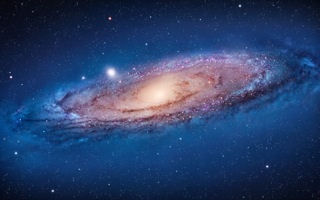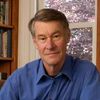[This is the 4th in the series Religion and Science: A Beautiful Friendship]
Man is a creature who makes pictures of himself,
and then comes to resemble the picture.
- Iris Murdock
The title of Mark Twain's What Is Man? poses a question that humans have pondered for millennia. Our species modestly calls itself Homo sapiens--Man, the wise. We've also been dubbed Man, the builder; the tool maker; the game player; and the talker. Twain himself argued that man is a machine, Homo machinus.

While all these characterizations capture some aspect of humanness, none does so uniquely. On the contrary, it seems that every time someone makes a case that a particular trait sets humans apart, experts in animal life say, "No, animals do that too." Animals show intelligence and build nests, dams, and webs. They make tools, play games, and make war. They communicate and display emotion.
But no species other than ours holds the fate of the Earth in its hands. The question, then, is what is it about humans that has brought us such power?
There's one faculty that humans have developed more than other animals. It's our capacity to build ever more accurate and comprehensive models that explain the world and nature and thereby give us a measure of control over it. In this context, you can think of models as explanations and stories--explanations of how the world works; stories about how we ourselves behave.
I'm not saying that other animals don't employ models. Once again, the distinction doesn't appear to be absolute. We may never know exactly when our hominid ancestors began inventing stories and telling fortunes, making maps and myths, keeping accounts and ledgers, depicting animals, explaining disasters, and speculating about death.
What's clear, though, is that these first steps to simulate aspects of the world and our place in it were taken at a time when there was no distinction between religion and science. Though we didn't think of it as modeling, building models was what we were doing. The crowning accomplishment of proto-religion and proto-science, which were then one, was the emergence of a model featuring us as individuals in the cosmos.
It's beside the point that these early models are now dismissed as "creation myths." What's important about them is not their validity but their existence. When humans began trying to explain the world, they embarked on a path that in time would give them a power advantage not only over other animals, but also over other human groups that handicapped themselves by clinging to inferior explanations.
Explanations, theories, maps, laws--models--are the path to power. Most of them are no good, but the few good ones rule. When models compete, better ones confer advantages on those who adopt them, and, over time, these first adopters gain an advantage over people saddled with models that harness and organize less power.
A Primer on Models
The sciences ... make models. By a model is meant a ... construct which, with the addition of certain verbal interpretations, describes observed phenomena. The justification of such a construct is solely and precisely that it is expected to work.
- John von Neumann (1903-1957), Hungarian-born American mathematician, creator of game theory and computer logic
Scientists use the terms "model," "theory," "explanation," and "law" almost interchangeably. The popular idea that a theory is more tentative than a model, or even a law, is quite wrong. These terms do not indicate relative degrees of certainty, but rather have their origins in history. For example, Newton's classical dynamics are referred to as "laws of motion" whereas the relativistic dynamics that Einstein discovered go by the name of the "theory of relativity." One might think the word law would indicate greater certainty, but in this case it's just the opposite. As of this writing, Einstein's "theory" has no known exceptions, and Newton's "laws" break down in the subatomic realm and for ordinary objects moving at high speeds.
Similarly, Darwin's "theory of evolution" is not so-named to suggest flaws in it. The theory of evolution has been thoroughly tested and to date has not been found wanting. Another very accurate, comprehensive scientific theory describes the elementary particles and their interactions. It goes by the unassuming name of "the standard model."
Building better models is humankind's defining activity. For better or worse, it's made us who we are. The aforesaid "standard model" describes three of Nature's four forces, and, by enabling us to predict their effects, allows us to tap sources of energy otherwise unavailable. The flip side of taming Nature's power is that we may use it in ways that damage the planet and harm each other.
We learn modeling early, starting with Legos, dolls, and model trains. The fables we grow up with can be understood as models that show us how to behave. People fancy themselves as characters in video games, sometimes deploying an avatar, and can try out different behaviors vicariously without risking their own lives.
Scientists Francis Crick and James Watson modeled the double-stranded helical structure of the DNA molecule with Tinker Toys. There is a model of the San Francisco Bay--complete with miniature piers poking into the water, a scaled-down Golden Gate Bridge, and "tidal currents" propelled by pumps--that fills a warehouse in Sausalito, California. By studying it, scientists can anticipate the effects of proposed real-world alterations of the Bay.
Weather bureaus, using computers and mathematical models, provide weather forecasts. As everyone knows, the predictions are not always right, but they're getting more accurate as the models are improved.
Experimenting with model planes in wind tunnels enabled the Wright brothers to build the aircraft they flew at Kitty Hawk. Even more significant than the plane they built was their pioneering use of modeling in engineering. Models enabled them to anticipate problems through trial and error without paying the price of crashing a piloted plane. Today, flight can be simulated on computers by representing both the airplane and the atmosphere in a mathematical model.
Grand unifying models are the holy grail of every branch of science. In biology, Darwin's theory of evolution by natural selection is such a model. In chemistry, it's Mendeleyev's periodic table of the elements. In geology, the theory of plate tectonics accounts for the earth's principal geological features. Physicists are searching for a "theory of everything" (often abbreviated TOE) that, as Leon Lederman, a Nobel laureate in physics, picturesquely puts it, would "explain the entire universe in a single, simple formula that you can wear on your T-shirt." One of these models is called string theory. Like all theories and models, string theory will ultimately live or die depending on whether its implications agree with observations.
Though much of science consists of building models, the use of models is hardly limited to science. Indeed, normative, prescriptive social models predate by millennia the descriptive and predictive nature models mentioned above. Beginning in the distant past, cultural codes of conduct--for example, the Ten Commandments--were used to regulate family and tribal relationships. Other examples of socio-political models include the theologies of religious institutions, organizational charts of universities, by-laws of corporations, and national constitutions.
Entrepreneurs and the venture capitalists who invest in their companies are guided by hypothetical plans--that is, models--that delineate scenarios based on various economic assumptions to chart a path to profitability. The governance models of nation-states range from the divine right of kings to fascism, communism, constitutional monarchies, and many sub-species of democracy. Sometimes users of social models actually lose sight of the difference between their models and reality. As Alan Greenspan, former Chairman of the Federal Reserve Bank, warns: "A surprising problem is that a number of economists are not able to distinguish between the models we construct and the real world."
When we see parents, heroes, public figures, and fictional characters as "role models," we're using behavioral models to shape our own character.
To sum up, models are descriptive or prescriptive representations of the world and ourselves. Their functions include providing us with an identity, shaping our behavior, maintaining social order, and guiding our use of power. Modeling has made humans what we are and our success as a species depends on learning to use them wisely.
In the next post, we face the fact that despite our preference for fixity, models evolve.
